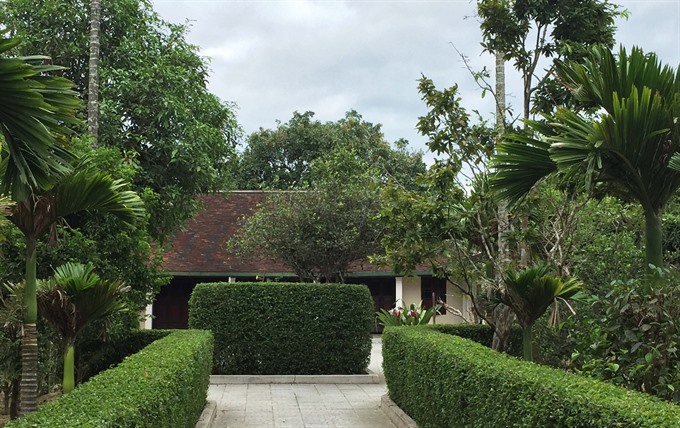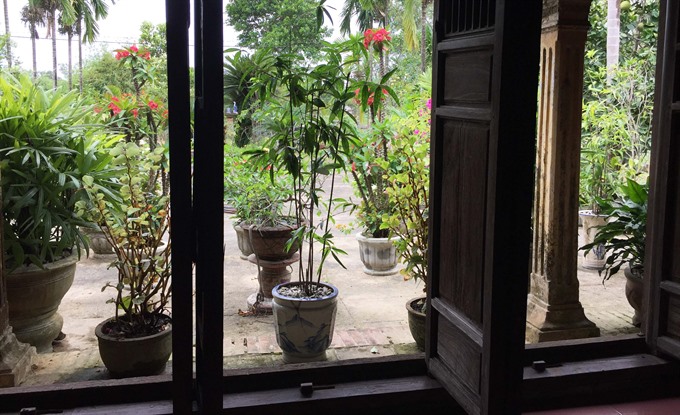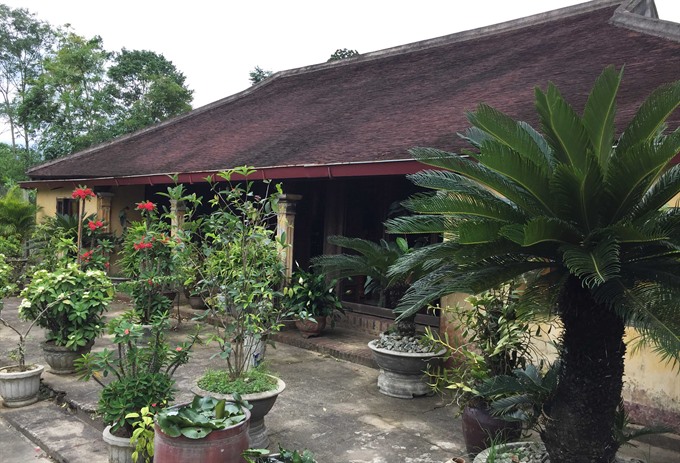Though they face each other across the Ô Lâu River, the old village of Hội Kỳ in Quảng Trị Province has had very different fortunes from its sister village Phước Tích in Thừa Thiên-Huế Province.

Lovely: The green ambiance with wild tea shrubs for fencing at a house in Hội Kỳ. — VNS Photo Phước Bửu
Both villages were born some 500 years ago when imperial troops and migrants from the northern delta came to conquer the new land. For five centuries, Hội Kỳ has sat on the right bank while Phước Tích stands on the opposite bank on the same section of the river.
But their fates differ. In the past, Phước Tích had more people than Hội Kỳ, so it had more old houses that could be protected. Today, about 30 old homes have been protected and restored in Phước Tích.
Phước Tích was recognized as a typical old village of the country in 2009. Thanks to the recognition, the nature, houses and scenes in Phước Tích have been well preserved since then. It has attracted several conservation projects, including one to revive its craft of pottery.
Hội Kỳ, despite its twin history and character, has not received as much attention and resources for heritage protection. A generation ago, many families still lived in Vietnamese-style old homes, consisting of wooden structures with many beams and pillars and earthen roof tiles. The homes were surrounded by yards and orchards. Since the 1990s, however, the number of old houses has dropped from 20 to five as locals seek larger and more modern homes.

Garden views: Nice yard with flower pots seen from inside an old house in Hội Kỳ.
— VNS Photo Phước Bửu
Dương Văn Mạnh, owner of the nicest house in the village, said that while preservation of the structures built by his ancestors was worthwhile, he saw no reason to maintain the property entirely - the green, natural ambiance created by the yards and orchards, for example, could be sacrificed to build more living space for his enlarged family.
He is constructing a concrete fencing system surrounding the land plot to replace the wild tea (Siamese Acalypha) fencing as he thinks the cement fence could more clearly identify the border.
In 2009, he built a two-storey modern structure attached to the 250-year-old wooden house left by his ancestors to create more living space.
Mạnh’s construction has ruined the original structure of the old garden house, which originally had two or three wooden structures for worshipping, living, cooking and sanitation needs. Those structures stayed in harmony with the surrounding nature, including a front yard for flower pots, a back yard for herbs and vegetables and wider orchard gardens.
“I prioritised protecting the (existing) wooden structure as a way to remember my ancestor, but I would change other aspects for daily needs,” he said.
Last year, local authorities cut down several parts of a bamboo range, which runs along the village and buffers the village’s main road and the river, to build washing docks. The construction of the new-style washing docks also destroyed the old brick docks built hundreds of years ago.

Heritage at home: One of the existing old wooden houses in Hội Kỳ. — VNS Photo Phước Bửu
Originally, the brick washing docks were created for the needs of bathing and washing on the river. They also gave villagers an ideal place for enjoying the cool breeze and fishing.
The earthen curvy roads in the village also got a concrete surface late last year. According to the cultural sector in Hải Lăng District, which included the village, there was no consideration of how the surface would affect the ambiance of the old village, as it has yet to be recognized as a heritage site.
Meanwhile, the Quảng Trị Department of Culture, Sports and Tourism said the process of conducting studies for recognition has been hindered by the owners of old houses as they do not want a surge of visitors after the heritage title.
The conflict between authorities who see preservation as a tool to bring more tourists to the area, and locals who value preservation but want to avoid more visitors, has stymied efforts to achieve official recognition for the village. Meanwhile, development in other sectors has proceeded inside the village, destroying the character everyone claims to want to protect.
All work to conserve the old homes has been undertaken by the owners by themselves, who try to protect the houses as much as they can, said Dương Bích Ngọc, a homeowner. The preservation of the old village seems to rely on its own efforts.